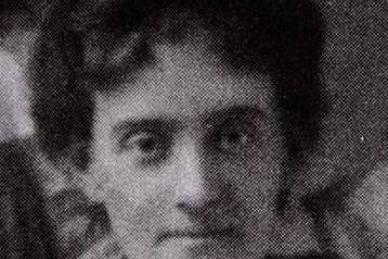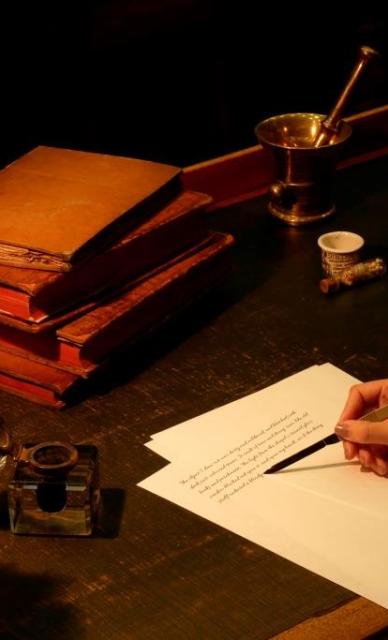Physicians' Gallery Newsletter
Updates on upcoming events, exhibitions and online stories
(1873–1962)
Licentiate

Russell helped found the Elsie Inglis Memorial Hospital in Edinburgh in 1925.
Beatrice Russell was born in Perth. The family tree, drawn by her daughter Helen, and reaching back to the eighteenth century, shows men in the various professions in Scotland, and some in India, but no close relations who were doctors, offering no clue as to why Beatrice chose medicine. Her father, James Ritchie (1822– 1913), a civil engineer, lived and practised in Perth, and was involved in building the railway network in the Highlands.
At a time of great prejudice against women in medicine Beatrice studied at Edinburgh at the Jex Blake School of Medicine for Women, where she was taught by her future husband, the pathology lecturer. Clinical teaching was at the Leith Hospital. Elsie Inglis was a contemporary. Beatrice took the Triple Qualification of the Scottish Royal Colleges in 1894, the year of her marriage, and proceeded to become MD with distinction at Brussels in 1895. Her husband’s anonymous obituarist in The Lancet described her in 1940 as a ‘brilliant Edinburgh licentiate’; however, while she had married William Russell, at the time an assistant physician at the Edinburgh Royal Infirmary of three years standing, she never practised medicine herself, although she did lecture alongside Elsie Inglis to the Edinburgh Health Visitors Association around 1908, between the births of her two sons in 1903 and 1912. She supported her husband in his increasing eminence by keeping an open but not lavish house in Walker Street, and reared an exceptionally gifted family. Her daughter Helen wrote years later:
. . . I suppose my parents were the mainstay, brought up without any superiority of sex, and medicine was the great profession in which we could all work together. My mother was ambitious for her daughters, and later for her sons . . . she did much to speed us on our way. We were a very affectionate family, surrounded by care.
When war broke out in 1914 Beatrice was swept along by her charismatic friend and neighbour Elsie Inglis into the organisation of the Scottish Women’s Hospitals; the War Office would not have women doctors in the RAMC until very much later in the war (the War Office banned the care of British casualties by these women until the grave military crisis of 1918), and Elsie Inglis’ urge for surgical action was coupled with the wish to demonstrate the equal worth of female doctors as a vindication of the non-violent suffragettes’ beliefs. The organisation was, of course, entirely voluntary; the collection of funds apart, Beatrice Russell took the most exposed part as chairman of the personnel committee. They started in October 1914, and the first volunteers were in France by December to deal with the French sick and wounded.
The Royaumont Hospital eventually had hundreds of active beds, and the women more than proved their case. Elsie Inglis took a smaller band to help the Serbs in the Balkans; when Serbia was overrun, Elsie Inglis was captured and repatriated before taking another hospital to Romania, where the remnants of the Serbian army were fighting. At the time she was dying, most probably of cancer. The hospital staff were caught up in the Russian revolution, and were eventually evacuated from Archangel to Newcastle upon Tyne. Inglis died two days after arrival.
Beatrice Russell stayed in Edinburgh during the war, for her son Scott was only two in 1914. The archives of the organisation of the Scottish Women’s Hospitals have been preserved, and document a monumental enterprise. The organisers and many of the executors were ‘well connected’, including the Commander-in-chief Sir John French’s sister Mrs Harley, who was killed at Monastir in 1917. Russell had to deal with innumerable problems; squabbles, pay, uniforms, supplies and even politics. The organisation tried to get the Foreign Office to intervene actively in the evacuation of the unit from revolutionary Russia and (more debatably) to give more support to the Serbian government in exile, the progenitor of the ill-fated Yugoslavia.
Russell went abroad only in the aftermath in 1919 when she went to Belgrade to wind up the hospital and plan the future use of the remaining funds. Dr Isabel Emslie (later Lady Hutton CBE), who had been at the sharp end of the organisation wrote to her mother about Russell and her colleague Miss Kemp ‘. . . Poor old girls, they are such genteel Edinburgh West Enders that I am very sorry for them . . . they were very pleased about it all and thought themselves no end of heroes coming out here . . .’. In 1928, she wrote about them in a book:
. . . both of them had done unceasing work . . . Our Committee was not composed of the kind of women who work for a few months . . . they worked on quietly and unostentatiously from beginning to end . . . they had a wonderful understanding of the situation . . . great appreciation of the good points of the Serbs and wonderful patience with their bad ones.
As the Scottish Women’s War Hospitals organisation was wound up, Russell became involved with the foundation of the Elsie Inglis Memorial Hospital in Edinburgh, run by women for women and babies, which flourished as a voluntary hospital from 1925 until it was taken over by the NHS and finally closed in 1992 as part of the centralisation policy of the Edinburgh hospitals.
Her daughter-in-law, Jean, remembers Beatrice as a warm and lovable person with many interests, both medical and non-medical. Beatrice cared for her husband in his old age and mental decline. She, too, eventually suffered from the dementia that afflicted her husband before dying at the age of 88.

Physicians' Gallery Newsletter
Updates on upcoming events, exhibitions and online stories